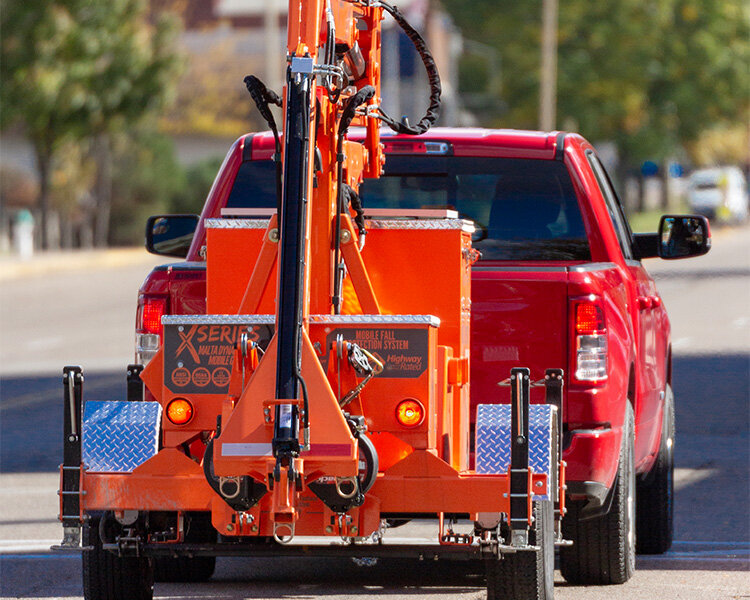Not only are falls the most common cause of workplace fatalities in construction, but fall protection is continually the most common OSHA violation. One of the excuses for lack of fall protection that I hear the most is the lack of a proper spot for an anchorage point. Finding anchorage points can definitely be a struggle in certain circumstances, which is why I was intrigued when I found the Malta Dynamics Mobile Grabber recently.

courtesy of Malta Dynamics
The Malta Dynamics X Series Mobile Grabber is a mobile fall protection device that provides an overhead anchorage point for those exact situations. The system is road-towable, has a relatively quick setup time, and can even be moved by a forklift for indoor use.
The Mobile Grabbers are currently offered in 4 different models, allowing a range of 2 users at one time up to 5 users, and an anchorage point height from 22 feet to 34 feet. Each anchorage point has a capacity of at least 310 pounds.
If a worker happens to fall while anchored to the Mobile Grabber, a person on the ground can quickly and easily lower the arm to safely return the fallen worker to the ground.
In addition to fall protection, the machine can also be outfitted with a rescue/retrieval device to safely raise or lower workers into or out of confined spaces. Other features and accessories include solar panels for power, hydraulic jacks, a wireless control remote, a strobe light, and generator mount.
To see what the Malta Dynamics X Series Mobile Grabber looks like in action, check out the video below (the good part starts at the 1:12 mark):
Last summer, Hilti announced that they had developed their first exoskeleton designed for construction tradespeople in a partnership with Ottobuck, a prosthetics, orthotics, and exoskeleton provider. Earlier this month, Hilti officially released the exoskeleton, announced more details, and published its retail price on their website.
[guest post] It’s a morbid statistic, but the construction industry experiences more workplace deaths than any other. With so many potential hazards, heavy-duty machinery, and power tools, it’s perhaps not surprising that serious accidents are relatively commonplace.
Even though we’re over a year into the COVID-19 pandemic, the virus is still threatening the health of construction’s workers and taking a toll on project timelines. It’s likely that your company has already determined the best course of action to help mitigate the risk of spreading the virus on your jobsites, but it’s never too late to learn from another contractor.
It’s been a little over a year since the coronavirus pandemic sent the entire world into a period of uncertainty, heartache, and panic. The construction industry itself has undertaken many different challenges, above and beyond keeping their people safe on the jobsite, many of which no one could have expected.
“You make a better door than a window!” is what I imagine loader operators constantly yell at the bucket in front of them (or maybe I’m just projecting based on my experience of having the habit of sitting right in front of the TV as a kid). Either way, operators may not be yelling that in the future, as equipment manufacturer, Doosan, has introduced what they claim is an industry first “transparent” bucket.
Reducing dust when cutting tile is important for many reasons (including safety and cleanliness), but wet tile saws can be a pain to use, with the slurry created spraying all around the work station and cold weather making the saw much more difficult to use outside. iQ Power Tools has a solution for that: the world’s first 7” portable dry table saw with integrated dust control.
In the construction industry, falls from height are continuously the leading cause of jobsite injuries, fatalities, and, as a result, OSHA citations. From May 3-May 7, OSHA invites construction employers and stakeholders to take part in their 8th annual National Safety Stand Down to Prevent Falls in Construction.
On Tuesday morning, February 23, the Syracuse Fire Department responded to a call about a collapsed crane on a construction site near the university. Thankfully, no injuries were reported.
It seems a little odd to be talking about air-conditioning when much of the United States hit some incredibly low temperatures in recent days, but a product that I learned about recently is just too exciting to ignore. Announced at CES 2021, a research company has unveiled an air-conditioned hard hat (ACHH) that can reduce the ambient temperature up to 22 degrees Fahrenheit!
2020 was a challenging year in many respects, but none greater than from a safety standpoint. The coronavirus pandemic placed the notion of “people over profits” under the microscope, while also balancing the needs of their employees to continue to make an income under difficult circumstances. While the pandemic was a large part of the construction safety conversation last year, there were several other developments to take note of for your projects in the future.












Shane is the creator of Construction Junkie and an active construction project manager. In his career, he has managed interior remodel projects, site development, construction safety, governmental project compliance, and facility maintenance. He has a strong passion for construction technology and safety, as well as sharing the knowledge or insights he has gained throughout his career.